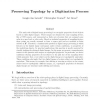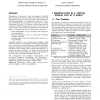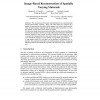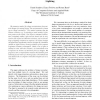PRESENCE
2002
14 years 2 months ago
2002
This paper presents a method for creating 3D models of real objects using video see-through augmented reality. We use a tracked probe to sample the objects' geometries and vi...
JMIV
1998
14 years 2 months ago
1998
The main task of digital image processing is to recognize properties of real objects based on their digital images. These images are obtained by some sampling device, like a CCD c...
CG
1999
Springer
14 years 2 months ago
1999
Springer
Augmented environments superimpose computer enhancements on the real world. Such augmented environments are well suited for collaboration of multiple users. To improve the quality...
SIGGRAPH
1997
ACM
14 years 7 months ago
1997
ACM
Manipulation in immersive virtual environments is difficult partly because users must do without the haptic contact with real objects they rely on in the real world to orient them...
RT
2001
Springer
14 years 7 months ago
2001
Springer
The measurement of accurate material properties is an important step towards photorealistic rendering. Many real-world objects are composed of a number of materials that often show...
HRI
2006
ACM
14 years 9 months ago
2006
ACM
The essence of the signal-to-symbol problem consists of associating a symbolic description of an object (e.g., a chair) to a signal (e.g., an image) that captures the real object....
HAPTICS
2006
IEEE
14 years 9 months ago
2006
IEEE
A central element of surgical simulators is the generation of appropriate haptic feedback. Several factors influence this rendering process, which could potentially degrade the f...
ICCV
2003
IEEE
15 years 5 months ago
2003
IEEE
We present a method for shape reconstruction from several images of a moving object. The reconstruction is dense (up to image resolution). The method assumes that the motion is kn...
ICCV
2003
IEEE
15 years 5 months ago
2003
IEEE
This paper presents a method to estimate geometrical, photometrical, and environmental information of a singleviewed object in one integrated framework under fixed viewing positio...




